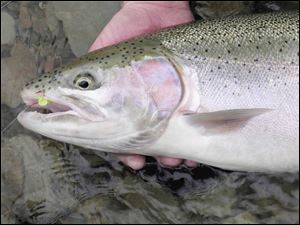
Contaminants in steelhead trout prompt warning
3/1/2007
The trout advisory involves tributaries in Lucas, Ottawa, Sandusky, Erie, Cuyahoga, Lake, Lorain, and Ashtabula counties.
Steelhead trout caught from Lake Erie tributaries should not be eaten more than once a month now, according to updated fish-consumption advisories to be released starting today with 2007 Ohio fishing licenses.
The Ohio Environmental Protection Agency's annual update, based largely on tissue samples from 318 fish, does not substantially change basic advice anglers have been given for years to avoid overexposure to cancer-causing polychlorinated biphenyls, or PCBs, as well as mercury and other contaminants that pollute the state's water bodies.
The enhanced trout advisory applies to Lake Erie tributaries in Lucas, Ottawa, Sandusky, Erie, Cuyahoga, Lake, Lorain, and Ashtabula counties, the state agency said.
In general, people are advised to limit consumption of Ohio fish to once a week agency spokesman Linda Oros said.
Some waterways, though, such as North Toledo's Ottawa River, have longstanding Ohio Department of Health advisories that warn people not to eat any fish caught from them.
Others, such as the Cuyahoga and Ohio rivers, have several species of fish that should not be eaten more than once every two months.
The advisories are based on a variety of factors that include average body fat and contaminants in fish tissue.
To minimize risk, cooks are advised to cut away fat and broil or bake instead of fry.
Much of today's water pollution, especially mercury, falls from the sky and settles on rivers, lakes, and streams after getting into the atmosphere from coal-fired power plants and other industrial sources as well as vehicle exhausts.
Some pollutants, though, are so hardy they have remained embedded in sediment. Certain industrial water discharges were banned under the federal Clean Water Act of 1972.
One bright spot: Sunfish and yellow perch are now deemed safe to eat twice a week under the new advisories.
The drawback: Fishermen have reported a steady decline in Lake Erie's yellow perch for years.
Advisories fluctuate from region to region.
Brown bullhead, for example, are generally safe to eat twice a week in northwest Ohio.
But in parts of northeast Ohio, they're so polluted they should not be consumed more than once every two months, Ms. Oros said.
For more specifics, residents are advised to check with local health departments, the state EPA, the Ohio Department of Natural Resources, and Women, Infant, and Children centers.
Contact Tom Henry at:
thenry@theblade.com
or 419-724-6079.